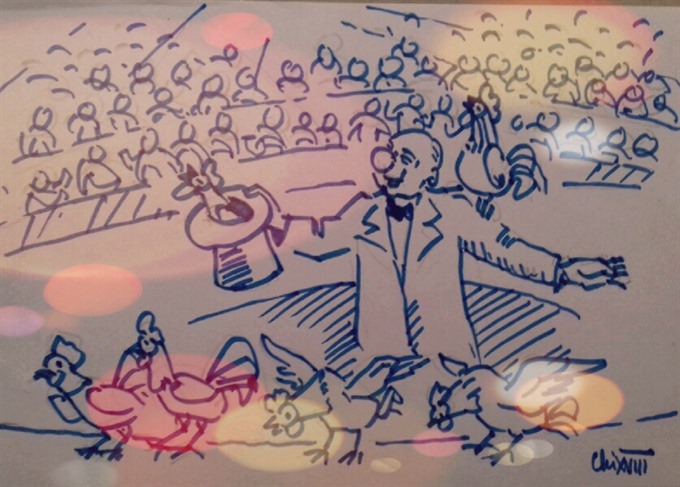 Society
Society

I have not been to an animal circus performance for a long time. Twenty years, perhaps, since I was about four or five.
 |
Bảo Hoa
I have not been to an animal circus performance for a long time, twenty years, perhaps, since I was about four or five years old.
Though I have no clear memories of watching the animals performing tricks, I remember the unpleasant smell of an elephant when it came near me. I was sitting somewhere in the front row, and I remember none of the animals looked comfortable while doing the show – they looked blank, like their minds were on auto-pilot, and they did not even know what they were doing.
I guess that blank look tugged at my young heart, and that’s why I have never been a fan of the animal circus.
Using animals in circus performances has been the centre of an ongoing debate – not only in Việt Nam but also around the world – for at least 20 years. The incident of Tyke - the elephant in Honolulu in August 1994 has become symbolic of circus tragedies, whose images can still shake to the core anyone who sees them today.
The Asia for Animals Coalition (AFA) recently sent a letter to the Minister of Culture, Sports and Tourism Nguyễn Ngọc Thiện calling for a ban on using wildlife animals in circus performances.
In their letter, AFA expressed their concerns on the abuse of animals in circus performances for entertainment purposes across Việt Nam. It cited a report recently published by the Animals Asia Foundation, which shows that 19 kinds of animals are being used for circus performances, including endangered ones.
These animals are being kept in extremely poor conditions, and are forced to perform unnatural acts with training techniques that psychologically “control” them by threat of violence and fear, according to the report.
AFA called for an investigation into the origins of these animals, and requested for collaboration from Minister Thiện to put an end to using animals in circus performances.
Like any other countries in the world where animal rights have become a concern, in Việt Nam there are two contradicting views on the matter. Pro-animal rights people think animals should be living in the wild. Meanwhile a lot of people think we should “create an environment where humans and animals can live together in harmony,” according to People’s Artist Tạ Duy Ánh, director of the Việt Nam Circus Federation.
I have many friends who root for AFA, who have witnessed animals like monkeys, bears and elephants suffer from training methods. They found training techniques like beating and whipping cruel and simply unacceptable.
I have never seen any such a training session, so I have nothing to say on that. But the sight of big animals like elephants, tigers and bears being held in captivity upsets me.
I visited the Central Circus in Hà Nội a few days ago and caught a glimpse of an adult elephant standing in a room that was barely wide enough for it to turn around. It felt wrong. It’s so different to the images of elephants pacing gracefully in desserts and pastures that I saw on National Geographic – where I think they should be.
In fact, trainers and circus managers in Việt Nam are well aware of the pro-animal rights view and some have changed their behaviour accordingly. They began making efforts to limit the use of wild animals in performances a few years ago.
“In the past three years we have tried to switch from wild animals to more domesticated ones like ostriches, pigs, cats, dogs, chickens and buffaloes,” said People’s Artist Tạ Duy Ánh during a press conference regarding AFA’s request.
“We also took the wild animals to the Thủ Lệ Park in Hà Nội, so that they can live out the rest of their lives in a more natural setting,” he added.
Animal training techniques have been improved at the major circuses like the Central Circus, according to Tống Toàn Thắng, deputy director of the Việt Nam Circus Federation.
“We don’t force the animals to perform in the traditional way anymore, but try to create conditioned reflexes in them instead,” he said.
“We treat them like our co-workers so that they perform voluntarily without being forced,” he added. “We instruct them so that they can mimic our actions.”
But none of these people have a clear answer to whether they will give up animal circus, partly because such a deliberate decision will drag along many consequences. One of them is that hundreds of trainers will lose their jobs.
What’s more, having gotten so used to being taken care of by humans, the circus animals won’t be able to survive on their own when released back into the wild, deputy director Tống Toàn Thắng of the Việt Nam Circus Federation said.
Animal trafficking and trading adds to the mayhem. A survey released by the Bear Rescue Center Vietnam in 2017 shows that the number of bears living in 22 bear sanctuaries in Việt Nam had decreased drastically in the past 20 years due to illegal poaching.
There is a lot to do in a developing country like ours regarding animal protection, and this will take a long time.
But whatever we choose to do, in my opinion, it’s best that we bear in mind that every creature on the planet deserves to live its life free from suffering and exploitation.
If we can’t provide animals with ideal living conditions, then at least we should stop using them as a means of entertainment.
“The animals of the world exist for their own reasons,” American novelist Alice Walker once said. — VNS




